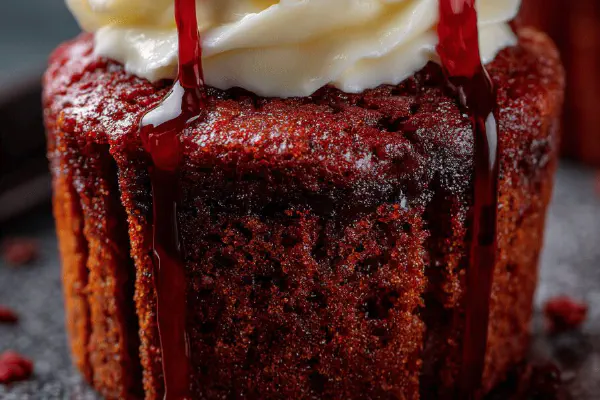Featured Recipe
Tangy Cream Cheese Frosting

By Kate
"
Cream cheese frosting with reduced sugar, swapped butter for light cream, and a lemon zest twist. Whip cream cheese first until velvety, then blend softened cream for creaminess. Add vanilla, salt, and lemon zest for brightness. Gradually sift powdered sugar to adjust thickness—look for thick peaks that hold shape yet yield under gentle swipe. Works great on carrot cake or chocolate cupcakes. Avoid overmixing or it breaks down. Using light cream keeps texture lighter, lemon zest sharpens flavor balance. Powdered sugar increments prevent over-sweetening and adjust to humidity or icing needs. Simple, flexible, kitchen-proof method.
"
Prep:
12 min
Cook:
0 min
Total:
12 min
Serves:
3 servings
frosting
desserts
baking hacks
Introduction
Cream cheese frosting. That tangy balance between rich and sweet. But most recipes go heavy on butter and sugar. Makes the texture thick but dense. I swap regular butter for light cream sometimes—gets a fluffier, lighter mouthfeel without sacrificing stability. The lemon zest? That little punch gives lift. Won’t overpower but cuts perfect through richness. Run the beaters on cream cheese first until totally lump-free. That step anchors the whole mix. Powdered sugar is your throttle—start moderate, then add slowly. Watch peaks form and hold shape rather than counting teaspoons blindly. Overmixed frosting breaks down, becomes runny. Quick mix, controlled texture, smart ingredients. This method works whether it’s carrot cake or chocolate cupcakes. Simple kitchen tricks that pay off every time.
Ingredients
About the ingredients
Cream cheese at room temperature is essential for lump-free beating. If cold, you’ll get stringy chunks that never smooth properly. Light cream instead of butter trims calories and adds fluff but can alter stability slightly, so don’t skip gradual sugar additions to compensate. Powdered sugar needs to be sifted before adding to avoid graininess. Lemon zest isn’t optional—it balances sweetness, adds complexity without overwhelms. Salt deepens flavor. Vanilla must be pure, avoid artificial; it melds all flavors. Storing frosting refrigerated can stiffen it; warming gently and stirring returns it to spreadability. If frosting gets too soft in humid kitchens, add a few more tablespoons of sugar rather than more cream. Bright acid ingredients (like lemon zest) help slow down frosting browning.
Method
Preparation
- Start whipping cream cheese alone with paddle or hand mixer. Target: no lumps, creamy texture. If cold, mix lumps will remain—room temp is key.
- Add softened light cream only once cream cheese is fully beaten. Beat on medium speed. Observe texture transition: slightly fluffier, lighter than butter would achieve.
- Mix in vanilla, salt, and lemon zest. Lemon zest adds subtle brightness, cuts through creaminess and sugar; don’t skip.
- Sift powdered sugar to prevent gritty frosting. Start with 3 cups—add slowly while mixer runs on low. Watch how frosting thickens. Should form soft peak that holds but is still spreadable.
- If frosting feels weak, add extra sugar by tablespoon increments. Too stiff? A small splash of cream loosens it. Adjust by texture not by time.
- Stop mixing as soon as consistency is reached. Overbeating breaks the mixture, becoming runny or curdled.
- Use immediately on cooled or room temp cakes, cupcakes, or bars. Refrigerate after use; bring to room temp and stir lightly before reuse.
Technique Tips
Start whipping cream cheese alone in bowl with paddle attachment or hand mixer. Beat until no lumps remain—check visually and by texture with spoon; should be satiny smooth. Add room temperature light cream in steady stream, continue mixing medium speed until combined fully, texture turns light but still stable. Mix in vanilla, salt, and lemon zest gradually so flavors distribute evenly. Powdered sugar must be sifted. Add 3 cups first. Mix on low speed carefully until frosted mixture thickens to soft peak that holds shape but yields under finger swipe. Add more powdered sugar in small increments if frosting seems too runny or won’t hold peaks—two tablespoons max at a time. Avoid overbeating as it causes structure collapse and can appear curdled. Color should be off-white, texture silky, thick but spreadable. Use immediately on cool desserts or store covered in fridge. Before reuse, stir gently and let soften at room temp short time.
Chef's Notes
- 💡 Use room temp cream cheese; crucial step. Cold cream cheese will lump. When mixing, aim for a velvety texture. No lumps. Sift that powdered sugar. Keep texture smooth.
- 💡 Watch the consistency. Soft peaks hold shape but shouldn’t be stiff. Mix on low speed. If it feels weak, adjust carefully with extra sugar. Small increments, don’t dump all at once.
- 💡 Lemon zest is a must. Adds brightness, balances sugar. Grate finely for distribution. Vanilla extract quality matters; go for pure over artificial. It blends flavors well.
- 💡 Store frosting in the fridge. But cold can stiffen it. When using again, take it out to soften at room temp. Gentle stir to bring it back. Don’t rush; too much mixing breaks it.
- 💡 Humidity changes frosting structure. If it feels too soft, add more powdered sugar. Avoid cream for thickening in wet kitchens. Always adjust based on texture, not time.
Kitchen Wisdom
How to fix runny frosting?
Start with adding small amounts of powdered sugar. Mix gently. Watch for thickening. Too much cream makes it worse.
Can I use butter instead of light cream?
Yes, but texture shifts. Butter gives richness, not fluff. If choosing butter, keep temperature steady.
What if frosting curdles?
Stop mixing immediately. Add small splash of cream. Lightly stir to salvage it. Curdling often happens from overmixing.
How long can I store this?
Refrigerate for a week max. Always seal well. If too stiff when reopening, let sit at room temp for a while.



